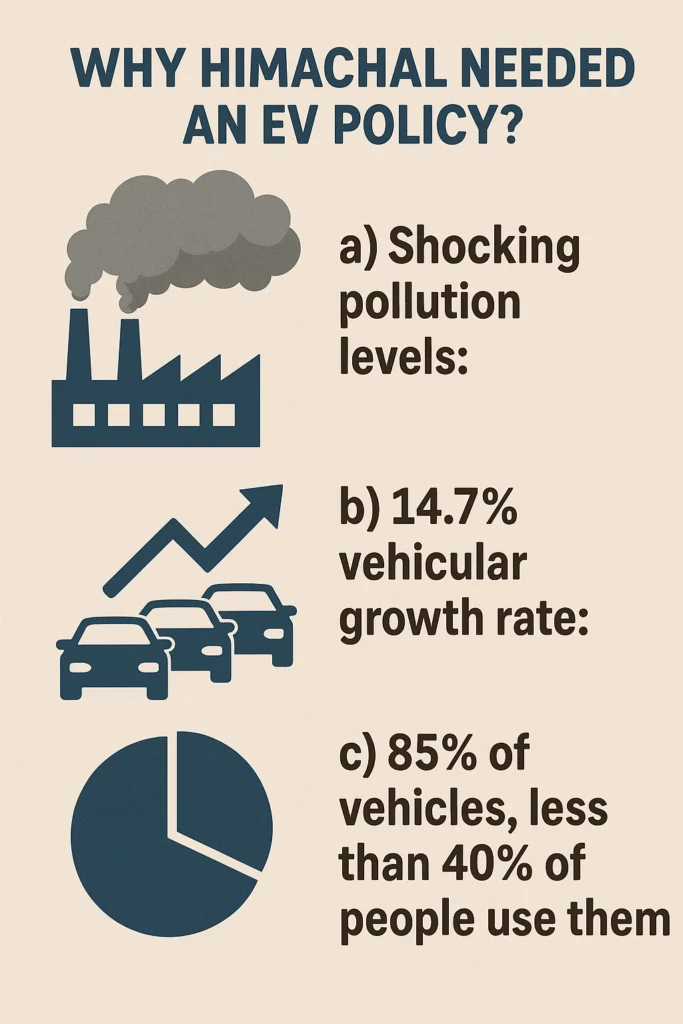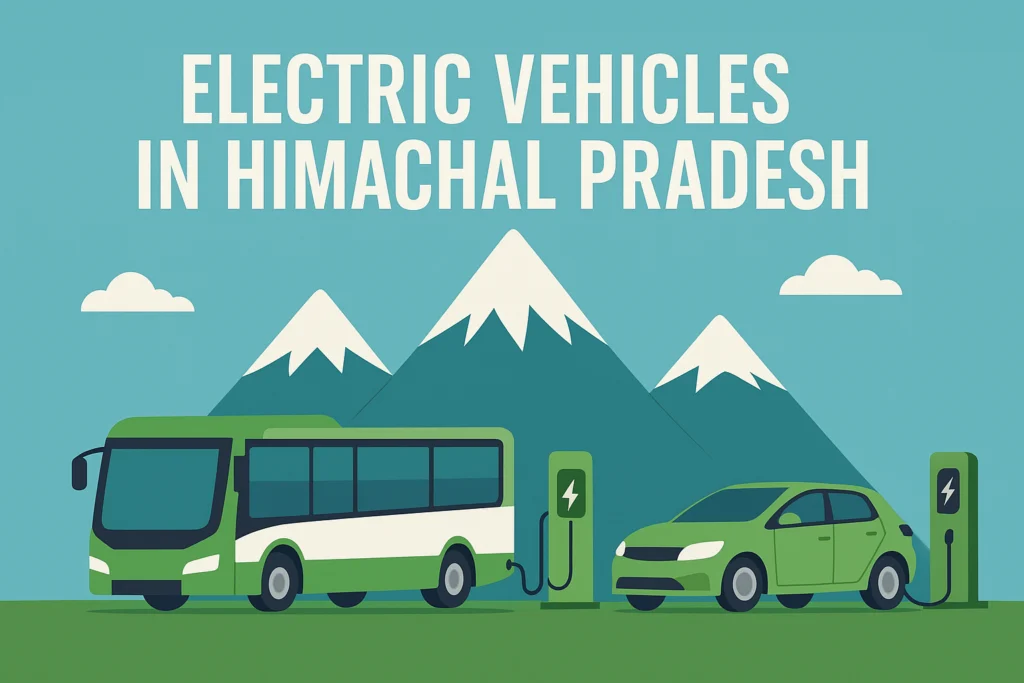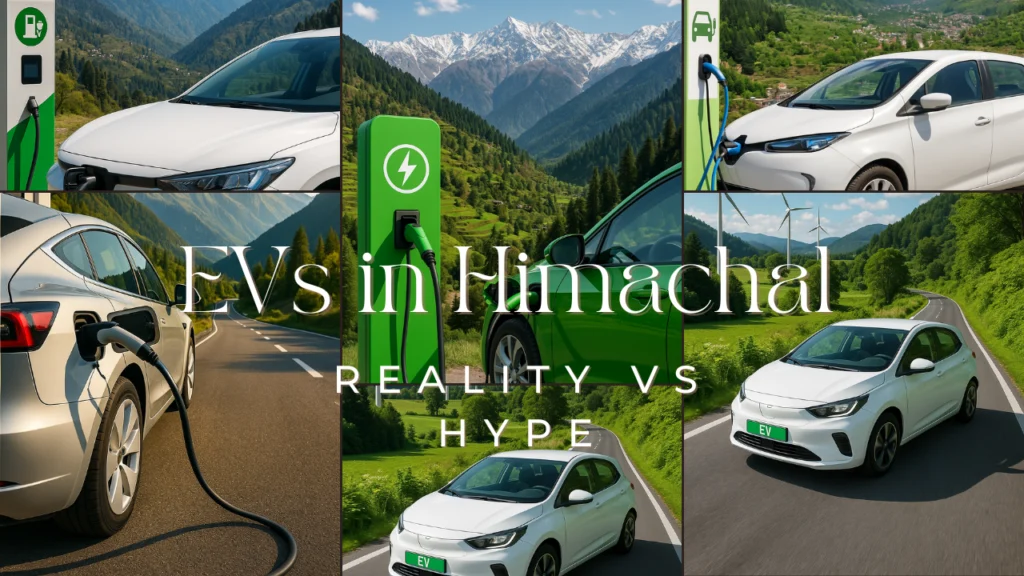Himachal Pradesh is globally admired for its pristine Himalayan beauty, faces the growing challenge of environmental degradation, significantly impacted by rising vehicular emissions. The state government has proactively embraced clean energy technologies, making it an early adopter of electric vehicles (EVs) in India. The Himachal Road Transport Corporation (HRTC) notably pioneered the introduction of electric buses among State Transport Undertakings (STUs).
Why Himachal Needed an EV Policy?

Shocking pollution levels:
- The state’s annual average RSPM concentration is 78.8 μg/m³, exceeding the national limit of 60 μg/m³.
- This indicates a serious air quality issue, particularly harmful for a fragile hill ecosystem.
14.7% vehicular growth rate:
- Himachal’s vehicle population is growing at 14.7%, well above the national average.
- This rapid rise has direct implications for pollution and traffic management.
85% of vehicles, less than 40% of people use them:
As of March 2021, a striking observation was that private vehicles made up a massive 85.42% of all vehicles in Himachal Pradesh (1,816,635 in total). However, these personal vehicles were used to transport less than 40% of people (specifically, 38.33%), a lower share than public transport like buses and taxis. This indicates that many people prefer their own vehicles, even if it means less efficient transport use, which puts more pressure on the environment.
On the brighter side, Himachal Pradesh has a significant advantage as Himachal produces more energy than it uses, 90% of this power coming from clean hydropower. This makes electric vehicles a perfectly suited, safe, energy-efficient, and environmentally friendly way to get around. To capitalise on this natural strength and tackle the environmental challenges, the Himachal Pradesh Electric Vehicle Policy, 2022, was introduced. This policy officially started on 10 January 2022 and is set to be in effect for five years.
What has the government done so far
The Himachal Pradesh government has undertaken several concrete steps to foster EV adoption and promote green transport
Existing Electric Fleet:
The Himachal Road Transport Corporation (HRTC) was the first State Transport Undertaking (STU) in India to introduce electric buses. Currently, HRTC operates 75 electric buses in Shimla and on the Manali to Rohtang Pass route, in addition to 50 electric taxis across various cities and towns in the state.
Planned Expansion of E-buses:
HRTC has issued tenders for the purchase of 297 electric buses for Rs 412 crore, with plans to acquire 500 more e-buses in the 2025-26 fiscal year. The government is also replacing diesel buses with e-buses in a phased manner to provide clean and green transport.
EV Adoption Targets:
The state government has set a target to replace 3,000 petrol and diesel vehicles with EVs this year. There’s also a broader goal of making Himachal Pradesh a green energy state by March 2026.
Charging Infrastructure Development:
- Charging stations are being established at bus stations for ₹ 124 crore.
- Six green corridors have been constructed in the state, and 41 additional charging stations are planned within these corridors.
- The Himachal Pradesh State Electricity Board Limited (HPSEBL) has been designated as the Nodal Agency for setting up charging infrastructure.
- Targets for charging stations include at least one charging station/point within every 1kmx1km grid in four model cities: Shimla, Mandi, Baddi, and Dharamshala.
- On highways, the target is at least one charging station (on each side) every 25 km on State highways, and at least one charging point (on each side) every 50 km on busy National Highways within the state.
Incentives and Subsidies:
- The government has launched the Rs 680 crore Rajiv Gandhi Swarojgar Startup Yojana, providing a 50% subsidy for youth to purchase e-taxis. 50 e-taxis have already been attached to government departments.
- There is a 100% exemption in road tax and a 50% exemption in special road tax on the registration of e-commercial vehicles. The HP state government also waives annual permit fees on commercial EVs. EVs registered in Himachal Pradesh and other states are also exempted from paying toll taxes on highways for the policy’s duration.
- The government offers subsidies of up to 40% on e-vehicles (buses or tempo travellers) for new permits on 1,000 bus routes opened to the private sector.
- Government Fleet Electrification:
- In the first phase, EVs will be used in all government offices in Hamirpur, the Chief Minister’s home district.
- Policy and Governance:
- The state aims to attract investments for EV manufacturing and research and development, proposing to allocate 100 to 200 acres for EV industrial parks. A single-window system is being developed to speed up the permissions for charging infrastructure.
- A dedicated EV Board/Cell/Council or Secretariat will be created to monitor policy progress and facilitate incentive transfers.
Is It Enough? On-Ground Reality
Himachal Pradesh’s electric vehicle (EV) charging infrastructure is expanding rapidly. Still, the on-ground reality indicates that current efforts may not yet be sufficient to achieve widespread electric vehicle (EV) adoption across the state. While there’s significant progress on paper, several challenges persist, particularly concerning real-world accessibility and reliability.
Emerging, Not Fully Operational Network
The government has approved 402 EV charging stations at strategic public locations, including the Public Works Department (PWD) / rest houses, Himachal Pradesh State Electricity Board Limited (HPSEBL) offices, and tourism sites. Additionally, six ‘green corridors’ have been mapped out across key highways, and partnerships with IOCL(Indian Oil Corporation Ltd) and private hotels aim to boost charging access in tourist zones. The Himachal Road Transport Corporation (HRTC) is also setting up charging stations at bus stations.
Despite these ambitious approvals, charging stations are currently operational, with most concentrated in urban hubs like Shimla and Manali and other cities. Much of the network is still in progressive rollout stages and not yet fully operational statewide.
On-Ground Gaps: Infrastructure vs. Accessibility
Actual accessibility remains limited, especially in rural and hilly regions such as Kinnaur, Lahaul–Spiti, Chamba, and remote parts of Kangra. Even on state highways, there are large stretches without charging facilities.
There is a mismatch between the deployment of charging stations and EV density. With less than 5,000 EVs registered (including approximately 500 e-taxis and 297 e-buses as of mid-2025), charging points are still sparse compared to registered vehicles. This sparsity means many potential EV owners, particularly outside the Shimla–Shimla-Manali and Dharamshala corridors, may find it difficult to rely on electric mobility today.
Challenges Ahead: Maintenance, Costs & Rural Readiness
Beyond the rollout, maintenance and reliability issues persist. National reports indicate frequent downtime in petrol-pump-based chargers and inconsistent app/User Charge Interface (UCI) usability, which hinders seamless charging even in urban zones.
High upfront EV costs and limited local incentives compound low adoption rates. The financial gap makes it difficult for middle and lower-income families in Himachal to transition to electric vehicles, even with central and state subsidies. Maintenance and battery replacement costs, along with limited second-hand EV options, also deter price-sensitive buyers.◦
Vehicle owners still heavily rely on traditional modes due to range anxiety and infrastructure gaps, particularly in remote valleys. The lack of basic EV infrastructure in small towns and remote regions makes long-distance or rural EV travel nearly impossible even today.
Slow Adoption Among Locals
Despite state subsidies, such as a 50% subsidy for e-taxis under the Rajiv Gandhi Swarojgar Startup Yojana, and growing awareness, EV adoption among local Himachali residents remains quite limited.
Himachal Pradesh has a clear and ambitious vision to promote clean mobility solutions through the widespread adoption of Electric Vehicles. With a target to become a green energy state by March 2026 and to have BEVs constitute 15% of new vehicle registrations by 2025, the government has laid a robust policy framework. Initiatives like the introduction of e-buses and e-taxis, the development of green corridors and charging infrastructure, and significant subsidies and tax exemptions underscore a strong commitment…. The state’s energy surplus from hydropower makes electric mobility a sustainable and eco-friendly choice.
Indeed, “The vision is real. But it’s only the first mile of a long journey.” While the policy and initial actions demonstrate a clear path, the continuous expansion of infrastructure, consistent demand generation, and addressing the various challenges of widespread adoption will be crucial in turning this vision into a complete reality by 2026 and beyond.
What Are the 6 Proposed EV Corridors in Himachal Pradesh?
As per the Himachal Pradesh Electric Vehicle Policy 2022, the 6 Green EV Corridors proposed and under development in the state are designed to enhance clean transport and improve charging infrastructure across key routes, especially for tourism and high-traffic areas.
- 1. Shimla – Mandi – Manali Corridor
- One of the busiest and most popular tourist routes in Himachal.
- Targets tourists traveling to Manali and Rohtang via Mandi.
- 2. Shimla – Solan – Parwanoo Corridor
- A major business and transit corridor connecting Shimla to the plains via Solan.
- Heavy vehicular traffic and industrial movement.
- 3. Shimla – Rampur – Kinnaur Corridor
- Extends towards the tribal and high-altitude regions of Kinnaur.
- Crucial for promoting clean travel in ecologically sensitive zones.
- 4. Mandi – Dharamshala – Pathankot Corridor
- Connects central Himachal to the northern border.
- Also, a significant religious and tourism route.
- 5. Baddi – Nalagarh – Chandigarh Corridor
- Industrial belt with high pollution levels and logistics movement.
- Important for introducing commercial EVs like e-trucks and delivery vans in coming future.
- 6. Hamirpur – Una – Nangal Corridor
- Part of the southern transport grid.
- Covers emerging towns and semi-urban expansion regions.
These corridors have been selected based on:
High traffic volume
Tourist potential
Pollution load
Proximity to hydropower surplus regions
Readiness for EV infrastructure deployment
📄 Download: Himachal Pradesh Electric Vehicle Policy 2022 (Official PDF)
Access the official document released by the Government of Himachal Pradesh outlining the vision, objectives, and incentives for electric mobility in the state.
FAQ’s
Frequently Asked Questions About Electric Vehicles and “EV Policy” in Himachal Pradesh
-
What is the Himachal Pradesh EV policy 2022?
It’s a five-year policy introduced on January 10, 2022, aimed at:
Boosting EV adoption across segments (personal, shared, commercial)
Developing EV manufacturing and R&D ecosystem
Making Battery Electric Vehicles (BEVs) account for 15% of new vehicle registrations by 2025. -
How many e-buses are running in Himachal?
As of mid-2025:
75 e-buses operational (Shimla + Manali–Rohtang). The Himachal government announced that 297 new buses will be available soon, 24 buses out of 297 will be super luxury buses.
Tenders issued for 297 more, with 500 more buses planned for FY 2025–26. -
Are charging stations available in remote areas?
Mostly urban-centric:
Charging infrastructure is being built in Shimla, Mandi, Baddi, and Dharamshala.
On highways: planned every 25 km (state) and 50 km (national).
Remote districts like Kinnaur, Chamba, etc., still lack widespread access. -
Can tourists use EVs in Himachal easily?
Yes, particularly in popular destinations like Shimla, Manali, and Dharamshala.
Government incentives include toll exemptions and e-taxis.
However, EV convenience for tourists is still limited in remote areas due to charger availability.





